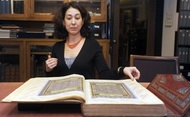In a quiet, windowless room deep inside the Walters Art Museum, a digitization specialist places a 900-year-old Quran into the cradle of the Stokes Imaging System. It's painstaking work, photographing one of the most important collections of Islamic manuscripts in North America, and slow. But scholars say the two-year project has put the Baltimore museum at the vanguard of a movement that is transforming the study of ancient texts.
Working with a $300,000 grant from the National Endowment for the Humanities, the Walters is placing its entire collection of Qurans and other Islamic pieces online, where high-resolution images of the roughly 230 often richly illuminated or illustrated pieces may be viewed free of charge by anyone with an Internet connection.
In a field where such documents typically are locked away in museums and universities scattered around the world, to be seen only by credentialed experts who are able to secure appointments for viewing, allowing such access is unprecedented.
"In many ways, what they're doing is a model for many other collections to emulate and follow up on," says Massumeh Farhad, chief curator at the Freer Gallery of Art and the Arthur M. Sackler Gallery of the Smithsonian Institution. "What the Walters is doing, which is slightly different from other institutions with collections of illustrated manuscripts, is they are putting all of their folios online."
The project is raising the profile of the Walters' collection. The Qurans, poetry, histories and other texts acquired by early 20th-century rail magnate Henry Walters date from the ninth through 19th centuries, and come from a geographical area stretching from North Africa to India.
"It will really promote collaboration between the Walters and other museums and organizations," says Fahmida Suleman, curator of modern Middle East holdings at the British Museum. "Because of the level of accessibility that they're giving us, it will be so easy for someone like me to trawl through their collection, figure out what they have, and then get in touch with them immediately and say, 'Right, I think we can collaborate.' "
Amy Landau sees another benefit. The Oxford-trained expert in Islamic art, who joined the Walters in October as assistant curator of rare books and manuscripts, turns the pages of a leather-bound Quran lavishly illuminated in still-bright gold and lapis lazuli. The Arabic text is supplemented by commentary in Arabic and Persian.
Landau calls it a masterpiece of calligraphy, of illumination and of bookbinding - "one of the most stunning examples of Quranic production that we have in our field."
The codex is believed to have been produced in northern India during the Timurid dynasty of the 15th and 16th centuries. Beyond that, little is known.
"So much is to be learned," Landau says. "There's work to be done in terms of students working on the translation of the commentaries. We say northern India, but we're not sure. There's a lot to be learned about the pigments used. There's some colors that we don't frequently find in Quranic production."
In letting the world at large have a look, Landau is hoping to get some answers.
"It's very important to remember that Islamic art is a very nascent field," she says. "It's not like Renaissance art history that's very well developed. We're just really beginning. People are now trained in the languages. There's more material documented. So there's still so much more to do in the field, and it's digitization projects such as this that make that possible. It's going to be a huge push forward."
The Walters is posting the images on its Web site, using a program that allows viewers to turn pages as if they were handling the actual object.
Related Links:
First step to revive calligraphy art in Crimea
In Abu-Dhabi Takes Place Exhibition of Unique Products of Islamic Art



